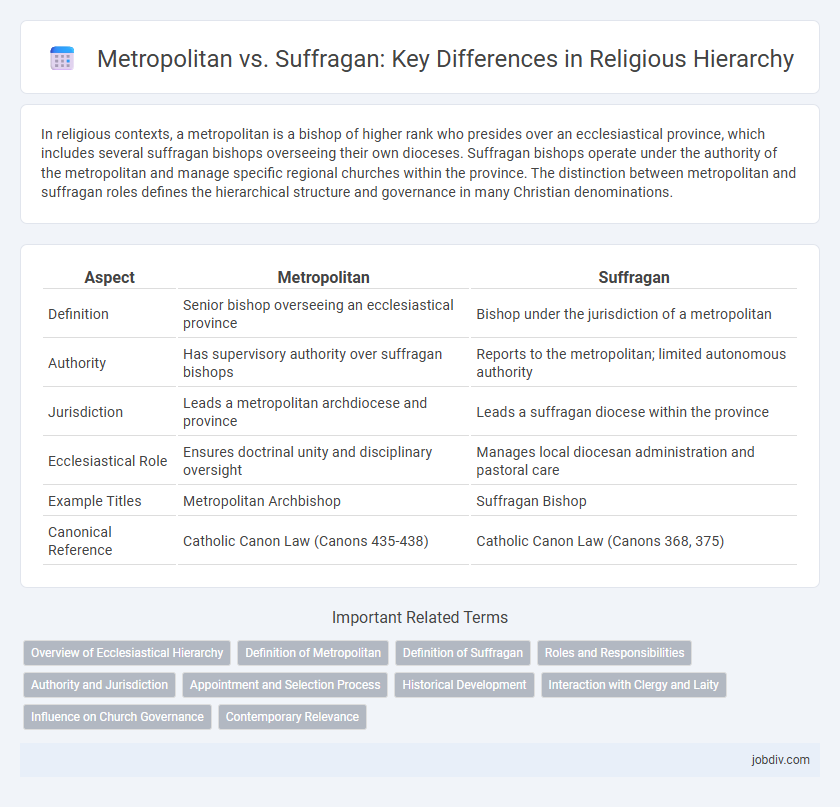In religious contexts, a metropolitan is a bishop of higher rank who presides over an ecclesiastical province, which includes several suffragan bishops overseeing their own dioceses. Suffragan bishops operate under the authority of the metropolitan and manage specific regional churches within the province. The distinction between metropolitan and suffragan roles defines the hierarchical structure and governance in many Christian denominations.
Table of Comparison
| Aspect | Metropolitan | Suffragan |
|---|---|---|
| Definition | Senior bishop overseeing an ecclesiastical province | Bishop under the jurisdiction of a metropolitan |
| Authority | Has supervisory authority over suffragan bishops | Reports to the metropolitan; limited autonomous authority |
| Jurisdiction | Leads a metropolitan archdiocese and province | Leads a suffragan diocese within the province |
| Ecclesiastical Role | Ensures doctrinal unity and disciplinary oversight | Manages local diocesan administration and pastoral care |
| Example Titles | Metropolitan Archbishop | Suffragan Bishop |
| Canonical Reference | Catholic Canon Law (Canons 435-438) | Catholic Canon Law (Canons 368, 375) |
Overview of Ecclesiastical Hierarchy
The ecclesiastical hierarchy distinguishes a Metropolitan as the chief bishop overseeing an ecclesiastical province, possessing authority over multiple suffragan bishops within that region. Suffragan bishops serve under the Metropolitan's jurisdiction, managing individual dioceses but lacking metropolitan privileges such as convening provincial councils. This hierarchical structure ensures organized governance and doctrinal unity across the church's territorial divisions.
Definition of Metropolitan
A metropolitan is a senior bishop who presides over an ecclesiastical province, which consists of several dioceses. Unlike suffragan bishops who assist the diocesan bishop without full jurisdiction, a metropolitan holds authority to oversee the suffragan bishops and ensure adherence to church doctrines within the province. This hierarchical role is pivotal in maintaining organizational structure and unity in many Christian denominations.
Definition of Suffragan
A suffragan bishop is a subordinate bishop within an ecclesiastical province who operates under the authority of a metropolitan bishop, overseeing a diocese that lacks full autonomy. This title signifies a bishop's role in assisting and supporting the metropolitan in administrative and pastoral duties while maintaining jurisdiction over a specific territory. The distinction highlights the hierarchical structure of church governance, where suffragan bishops serve as essential links between local dioceses and the provincial metropolitan.
Roles and Responsibilities
A Metropolitan oversees an ecclesiastical province, providing spiritual leadership and coordinating activities among suffragan dioceses, ensuring doctrinal unity and administrative order. Suffragan bishops manage individual dioceses under the Metropolitan's guidance, focusing on pastoral care, local governance, and implementing church policies within their jurisdiction. The Metropolitan holds authority to convene provincial synods and serves as the primary liaison between suffragan bishops and higher church hierarchy.
Authority and Jurisdiction
Metropolitan bishops hold authoritative oversight over multiple suffragan dioceses within an ecclesiastical province, exercising supervisory powers in matters of doctrine and discipline. Suffragan bishops have jurisdiction limited to their individual dioceses, operating under the metropolitan's guidance but maintaining administrative autonomy. The metropolitan's role includes convening provincial councils and ensuring uniformity across suffragan sees, emphasizing hierarchical authority within church governance.
Appointment and Selection Process
The appointment of a Metropolitan is typically overseen by the highest ecclesiastical authority, such as a synod or the Pope, reflecting their role as a senior bishop overseeing multiple dioceses. In contrast, a Suffragan bishop's selection is usually conducted at the diocesan level, often involving local clergy and lay representatives, with confirmation from the Metropolitan or patriarch. The hierarchical structure ensures that Metropolitans have broader jurisdictional authority, while Suffragans assist within a specific diocese under the Metropolitan's supervision.
Historical Development
The historical development of the metropolitan and suffragan sees dates back to early Christianity when metropolitan bishops gained authority over surrounding dioceses to maintain ecclesiastical unity. The concept was formalized during the Council of Nicaea in 325 AD, establishing metropolitan bishops as leaders with jurisdiction over suffragan bishops within a province. Over time, this hierarchical structure evolved to manage growing Christian communities and solidify church governance across expanding territories.
Interaction with Clergy and Laity
A Metropolitan holds ecclesiastical authority over suffragan bishops within an ecclesiastical province, often guiding clergy through synods and facilitating collaboration among dioceses. Suffragan bishops primarily focus on pastoral care and administration within their own dioceses, maintaining direct interaction with local clergy and laity. The Metropolitan's role emphasizes coordination and oversight, ensuring doctrinal unity and mutual support across suffragan jurisdictions.
Influence on Church Governance
Metropolitans hold authority over a group of suffragan bishops within an ecclesiastical province, significantly shaping church governance through their power to convene provincial synods and oversee doctrinal unity. Suffragan bishops operate under the metropolitan's jurisdiction, managing individual dioceses but deferring to the metropolitan on broader ecclesiastical decisions. This hierarchical structure ensures centralized oversight while maintaining local diocesan administration within the wider framework of the church's canon law.
Contemporary Relevance
Metropolitans hold jurisdiction over multiple dioceses within an ecclesiastical province, providing administrative leadership and unity in contemporary church governance. Suffragan bishops operate under the metropolitan's authority, managing individual dioceses while contributing to regional collaboration and pastoral care. The distinction remains crucial in modern religious structures for maintaining hierarchical order and facilitating coordinated responses to social and spiritual challenges.
Metropolitan vs Suffragan Infographic

 jobdiv.com
jobdiv.com